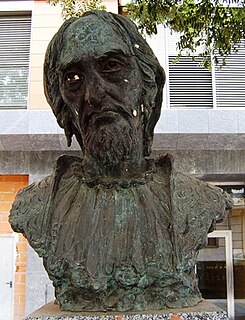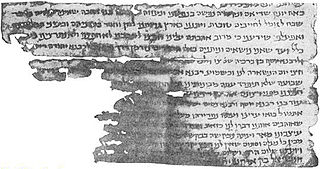
Hai ben Sherira better known as Hai Gaon, was a medieval Jewish theologian, rabbi and scholar who served as Gaon of the Talmudic academy of Pumbedita during the early 11th century. He was born in 939 and died on March 28, 1038. He received his Talmudic education from his father, Sherira ben Hanina, and in early life acted as his assistant in teaching. In his forty-fourth year he became associated with his father as "av bet din," and with him delivered many joint decisions. According to Sefer HaKabbalah of Rabbi Abraham ben David (Ravad), he was the last of the Geonim.

Adiabene was an ancient kingdom in northern Mesopotamia, corresponding to the northwestern part of ancient Assyria. The size of the kingdom varied over time; initially encompassing an area between the Zab Rivers, it eventually gained control of Nineveh, and starting at least with the rule of Monobazos I, Gordyene became an Adiabenian dependency. It reached its zenith under Izates II, who was granted the district of Nisibis by the Parthian king Artabanus II as a reward for helping the Parthian to regain his throne. Adiabene's eastern borders stopped at the Zagros Mountains, adjacent to the region of Media. Arbela served as the capital of Adiabene.
Judah ben Samuel of Regensburg, also called Yehuda HeHasid or 'Judah the Pious' in Hebrew, was a leader of the Chassidei Ashkenaz, a movement of Jewish mysticism in Germany considered different from the 18th-century Hasidic movement founded by the Baal Shem Tov.

Moses de León, known in Hebrew as Moshe ben Shem-Tov, was a Spanish rabbi and Kabbalist who is considered the composer or redactor of the Zohar. It is a matter of controversy if the Zohar is his own work, or if he took traditions going back to Rabbi Shimon bar Yohai and committed them to writing. His other works include Sefer ha-Rimon, written in Hebrew.
Moshe haDarshan was chief of the yeshiva of Narbonne, and perhaps the founder of Jewish exegetical studies in France. Along with Rashi, his writings are often cited as the first extant writings in Zarphatic, the Judæo-French language.
Rabbi Yishmael ben Elisha, often known as Rabbi Yishmael and sometimes given the title "Ba'al HaBaraita", was a rabbi of the 1st and 2nd centuries.

Josippon is a chronicle of Jewish history from Adam to the age of Titus. It is named after its supposed author, Josephus Flavius, though it was actually composed in the 10th century in south Italy. The Ethiopic version of Josippon is recognized as canonical by the Ethiopian Orthodox Church.
Nicholas Donin of La Rochelle, a Jewish convert to Christianity in early thirteenth-century Paris, is known for his role in the 1240 Disputation of Paris, which resulted in a decree for the public burning of all available manuscripts of the Talmud.

Chushiel ben Elchanan was president of the bet ha-midrash at Kairouan, Tunisia toward the end of the 10th century. He was most probably born in Italy, but his origins and travels remain obscure, and his eventual arrival in Kairwan is the subject of a well-known story.

Midrash Tadshe is a small midrash which begins with an interpretation of Gen. 1:11:
"And God said, Let the earth bring forth". R. Pinchas asked, "Why did God decree that grass and herbs and fruits should grow upon the third day, while light was not created until the fourth? To show His infinite power, which is almighty; for even without the light He caused the earth to bring forth [while now He creates all manner of trees and plants through the operation of the light]."

A number of midrashim exist which are smaller in size, and generally later in date, than those dealt with in the articles Midrash Haggadah and Midrash Halakah. Despite their late date, some of these works preserve material from the Apocrypha and Philo of Alexandria. These small works, were in turn used by later larger works, such as Sefer haYashar (midrash) and Zohar. Important editors and researchers of this material include Abraham ben Elijah of Vilna, Adolf Jellinek, and Solomon Aaron Wertheimer.
Simeon ben Helbo Kara was a French rabbi who lived in Mans in the 11th century; brother of Menahem ben Ḥelbo and father of Joseph Ḳara. For the meaning of his surname see Joseph Ḳara. Isaac de Lattes, in his Ḳiryat Sefer, counts Ḳara among the prominent French rabbis, although no work of his has survived. J.L. Rapoport identified him with the compiler of the Yalḳuṭ Shim'oni, on account of the similarity of some Midrashic quotations in this work with citations in Rashi's Bible commentary. Abraham Epstein has, however, shown that in the manuscripts the name "Ḳara" does not occur, and in place of "Simeon" the reading "Simson" at times is found.
Natronai Ben Hilai was Gaon of the Sura Academy early in the second half of the 9th century, and held this post for ten years. He is responsible for more written responsa to queries posed to him by world Jewry than any of his predecessors, and maintained close contact with the Spanish Jewish community.
Simeon Kayyara, also spelled Shimon Kiara, was a Jewish-Babylonian halakhist of the first half of the 8th century. Although he lived during the Geonic period, he was never officially appointed as a Gaon, and therefore does not bear the title "Gaon."

Midrash Eleh Ezkerah is an aggadic midrash, one of the smaller midrashim, which receives its name from the fact that a seliḥah for the Day of Atonement, which treats the same subject and begins with the words "Eleh ezkerah," recounts the execution of ten famous teachers of the Mishnah in the time of the persecution by Hadrian. The same event is related in a very ancient source, Eichah Rabbah.
Abraham Castanho was a Spanish poet who lived at Amsterdam in the middle of the 17th century. He was the author of an elegy on the martyr Abraham Nuñez Bernal, who was burned at Córdoba May 3, 1655. It was inserted in Elogios que Zelosos Dedicaron á la Felice Memoria, etc., published probably at Amsterdam in 1656.
Isaac ben Dorbolo was a rabbi, about 1150.
Isaac de Castro Tartas was a Marrano and Jewish martyr.
Kalonymos or Kalonymus is a prominent Jewish family who lived in Italy, which, after the settlement at Mainz and Speyer of several of its members, took during many generations a leading part in the development of Jewish learning in Germany. The family is according to many considered the foundation of Hachmei Provence and the Ashkenazi Hasidim.
Hutzpit the Interpreter was a rabbi from the third generation of tannaim.
![]() This article incorporates text from a publication now in the public domain : Singer, Isidore; et al., eds. (1901–1906). "Smaller Midrashim". The Jewish Encyclopedia . New York: Funk & Wagnalls. Its bibliography:
This article incorporates text from a publication now in the public domain : Singer, Isidore; et al., eds. (1901–1906). "Smaller Midrashim". The Jewish Encyclopedia . New York: Funk & Wagnalls. Its bibliography:




